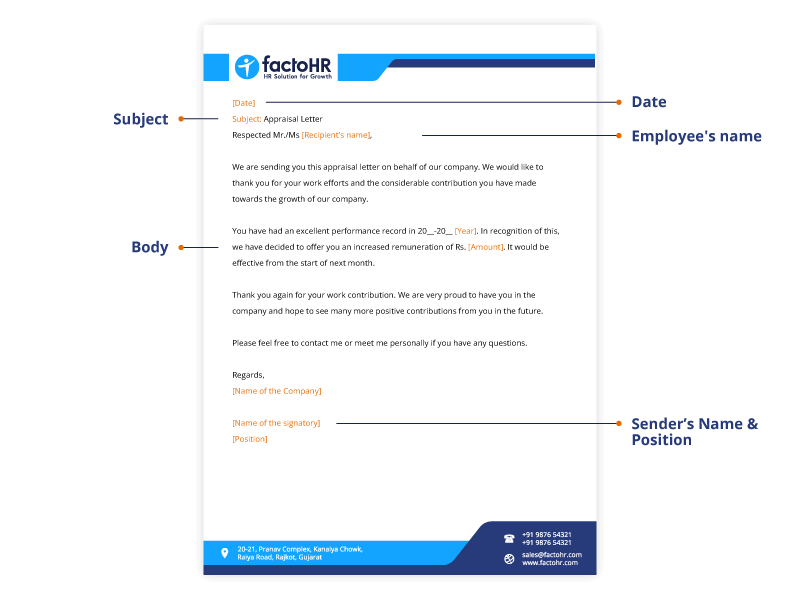Appraisal Letter Format: Employee Performance Template

Table of Contents
An appraisal letter is provided to the employee once their performance review is completed. If carried on rightly, it can become a great motivation for employees, eventually leading to the organization’s success. Such documents encourage staff and are beneficial for an organization. When issued properly, such letters increase motivation and encourage development.
An effective letter of this sort comments on what the employee has done well, what they need to work on, and how to get better. It is also an appropriate tool for expressing appreciation and for initiating discussions on future career prospects. If this is your first time drafting an appraisal letter, you are in the right place. We’ll guide you through the essentials and share a free template.

What is an Appraisal Letter?
An appraisal letter is a document that states an employee’s significant contributions, percentage of increment, and revised salary breakdown. It is given to employees after an organization conducts a predefined performance appraisal process. It is written by HR professionals specifically to praise employees’ performance.
The letter signifies that the employer recognizes and encourages the employees’ efforts, motivating them to strive for even better performance.
Why is an Appraisal Letter Important?
An appraisal letter is a written document, preferably in a formal tone, which details the performance of an employee and acknowledges performance. It also highlights the interest of the company in the development of the employee.
Here’s why it matters:
Improves Morale & Workplace Satisfaction
Appraisal letters can help boost employee morale and motivation, which are crucial factors in maintaining high levels of engagement and good working relationships, by recognizing accomplishments and showing appreciation.
Increases Openness and Equity
A properly worded appraisal letter conveys an organization’s dedication to fairness and objectivity, and shows that merit is at the heart of performance reviews and rewards.
Helps You to Enhance Your Career
Appraisal letters form the foundation of personal development plans that identify training needs and potential opportunities for development within the organization.
Salary Appraisal Letter Format

A salary appraisal letter should be formal, professional, and clear. It should include the new salary, the effective date, and appreciation for the efforts of the employee. Here is a common format:
[Company Letterhead]
Date: [DD/MM/YYYY]
To,
[Employee Name]
[Designation]
[Department]
Dear [Employee Name],
We are glad to tell you that, based on your performance achieved during the period of assessment, your salary will be adjusted accordingly. Revised pay structure comprises [Revised Salary Amount] per [month/year] starting [Effective Date].
We thank you very much for your dedication, hard work, and great help in helping the organization succeed. We hope this motivates you to continue doing your best, and we wish you continued success in your role.
Best regards,
[Manager/HR Name]
[Designation]
[Company Name]
Grab Your Free, Friendly Appraisal Letter for Employee Format

Samples for Appraisal Letter for Employee
Appraisal letters can be of different types based on their purpose, such as a performance evaluation, appreciation, a pay hike, or even a self-assessment. Below are some sample formats that organizations and employees can rely on in different scenarios.
Sample 1: Performance Appraisal Letter
A performance evaluation letter is a way to recognize an employee’s work during the evaluation period, to praise them for their accomplishments, and to motivate them. It is part of the recognition and reward for future development.
[Company Letterhead]
Date: [DD/MM/YYYY]
To,
[Employee Name]
[Designation]
[Department]
Performance Appraisal outcome (Job-Based Observation)
Dear [Employee Name],
We would like to inform you of your performance evaluation for the period [year/duration]. I have been very impressed by your dedication to specific projects/initiatives and your commitment to team objectives.
We hope you will continue to be the best, and we look forward to seeing you grow with us.
Best regards,
[Manager/HR Name]
[Designation]
[Company Name]
Sample 2: Recognition and Awards Appraisal
An appraisal letter that recognizes and rewards achievements is necessary for an employee who has met and exceeded set targets. Such a letter serves as a reminder of how one’s work is appreciated, the award or recognition received, and how outstanding their work is.
Template:
[Company Letterhead]
Date: [DD/MM/YYYY]
To,
[Employee Name]
[Designation]
[Department]
Subject: Performance and Award Recognition
Dear [Employee Name],
This gives us joy to recognize your efforts and achievements within the review period. Your work in [specific project/initiative] no doubt sets a benchmark, and having received [the Award/Recognition Name], we are honored to celebrate your achievement.
You are indeed very committed and dedicated, and we look forward to your success and valuable contributions to the company.
Best wishes,
[Manager/HR Name]
[Designation]
[Company Name]
Sample 3: Salary Increment Appraisal
An appraisal letter is a communication sent to an employee that mentions the revision of their remuneration. The revision is based on the employee’s performance over time.
[Company Letterhead]
Date: [DD/MM/YYYY]
[Employee Name]
[Designation]
[Department]
Subject: Notice of Salary Increment
Dear [Employee Name],
Following your exemplary performance and productive efforts during [specific project/goal] for which a pay raise had been planned, we are glad to inform you that you will be rewarded with an increase in salary from [Effective Date].
It is our strong desire to appreciate your efforts, dedication, and commitment towards the organization and to thank you for the services you have rendered. We are certain you will remain committed to assisting the organization in achieving greater goals.
Best wishes again!
Warm regards,
[Manager/HR Name]
[Designation]
[Company Name]
Sample 4: Self-Appraisal Letter Format
A self-appraisal letter allows employees to determine their accomplishments, strengths, and areas of development within a review period. It helps the management to understand what employees think and what they want to accomplish in the future.
[Employee Name]
[Designation]
[Department]
Date: [DD/MM/YYYY]
To,
[Manager/HR Name]
[Designation]
[Company Name]
Name: Self-Appraisal of [Year/Review Period].
Dear [Manager/HR Name],
I am submitting my self-appraisal for the review period of [year/ duration]. From my review, I have made the following contributions during this period – [mention key projects/achievements]. My contributions have helped achieve the outcomes of [team/organization name], which include [specified outcomes/achievements].
Moreover, working on [specific areas] has given me the chance to sharpen my skills, which has improved my performance. I want to thank you for your advice during this course.
Sincerely,
[Employee Name]
Sample 5: Appraisal Email Sample
An appraisal email is a short and formal communication sent to notify employees of the outcome of their appraisal.
Format:
Subject: Performance Appraisal Outcome – [Employee Name].
Dear [Employee Name],
It is my great pleasure to inform you that your performance appraisal during the period [year/duration] has been successfully completed. You have been of great help in [specific tasks/projects], and we are grateful that you continue to stay with us.
Because of your job, [describe result – recognition, increment, or new responsibilities]. We encourage you to continue doing so and continue to do a wonderful job.
And congratulations and thanks once more on your precious contributions.
Best regards,
[Manager/HR Name]
[Designation]
[Company Name]

How to Write an Appraisal Letter with Tips?
An appraisal letter refers to a formal letter, usually sent by an employer to the employee, to notify the employee about their performance appraisal. Its principal aim is to reward an employee on the basis of their work performance, to offer constructive criticism, to encourage the employee to do better, and to inform them about a salary increment, a raise, or a promotion.
Begin with Employee Information and Intent
Indicate clearly the name of the employee, job position, and reason why the letter was written (performance review).
Give a Performance Summary
Give a brief and clear profile of the overall performance of the employee, with reference to specific achievements and strengths.
Provide Constructive Feedback
Discuss problem areas in a subtle way with given examples and recommendations.
Include Information on Pay and Promotions
Inform the employee about a pay rise, bonus, or job promotion.
Set Future Goals
Establish specific and achievable objectives that are consistent with the objectives and targets of the company in order to support sustained professional development.
What is the Purpose of Writing a Letter of Appraisal to an Employee?
An appraisal refers to a process of analyzing the employee’s job performance in relation to a specific set of standards, competencies, and goals. It is a combination of results (what was accomplished) and behaviors/competencies (how it was performed) to inform development and administration.
When to Write an Appraisal Letter?
Following performance incremental cycles after one or two annual or biannual performance cycles to verify ratings, increments, and goals.
- On completion of probation, to establish confirmation, extension, or separation.
- After the change of role or increase in rank, record new expectations and remuneration.
- To make mid-cycle changes when objectives, strategy, or performance material change.
- Complete a series of major projects to complete deliverables and identify subsequent milestones.
- Where the law or policy compliance involves a written assurance of consequences.
Appraisal Types

1. Rating Scales
Numeric/descriptor scales of goals, competencies, and values.
2. Management by Objectives (MBO)/OKRs
Objective-setting appraisal relative to negotiated targets.
3. 360-Degree Feedback
The contribution of manager, peers, reports, and occasionally clients.
4. Behaviorally Anchored Rating Scales (BARS)
Role-specific behavioral anchors by level.
5. Critical Incident Method
Positive/negative events of some importance with evidence.
6. Self and Peer Appraisal
Employee and peer views to add to calibration.
7. Assessment Centers
Role-readiness simulations and standard exercises.
Appraisal vs Review Letter: Know the Difference
Rating, compensation adjustment, title adjustments, and negotiated targets are contained in an appraisal letter. The narrative assessment, which describes evidence, context, and coaching, is a performance evaluation/review letter/report. In many organizations, the report precedes the appraisal letter, although in other organizations, they are combined.
Appraisal vs Appreciation Letter: What is the Difference
An appraisal letter is assessor, periodic, and outcome-consequential (ratings, pay, promotion, PIP, or goals). The appreciation letter is recognition at will: it is based on one particular contribution, milestone, or behavior; the recognition is motivational, does not involve grades, and is not likely to change compensation or position.

Turn Feedback into a Feel-Good Letter. Start with factoHR.
The authenticity of an appraisal letter stems from its clarity, alignment, and momentum. Compiling performance information into a short, standardized report assists in describing how results compare against the expectations, why a reward or penalty is provided, and what a higher-level achievement would resemble.
When well executed, it instills trust, moves the process towards strategy, and provides written documentation that protects the organization and the employee. Tie it to timely coaching and measurable goals, and it becomes a growth and retention, and fair pay driver, something that can be used strategically across the board.
What does an Appraisal Mean?
Purpose of writing a letter of appraisal to an employee: It regulates performance feedback, connects outcomes to pay and promotion decisions, and establishes development objectives in the next cycle. It also generates a justifiable history that promotes equality, harmony, and future human resource planning.
When to Write an Appraisal Letter?
Write it at the close of annual or semiannual periods, on termination of probation, or on material change of role or projects. Take it when there are mid-cycle recalibrations required of goals, when there are substantial changes in goals, or when policy or compliance has to be formally documented.
What are some Types of Performance Appraisal?
Some common ones are 360-degree feedback, management by objectives (MBO), self-assessment, rating scales, and behaviorally anchored rating scales (BARS). All these methods examine performance in various dimensions to provide an overall picture.
Is an Appraisal Letter Different from a Performance Evaluation or Review Letter?
Yes, an appraisal letter is a written document that officially announces a salary increase or a promotion, whereas a performance evaluation or review letter reports extensively on the performance of a worker. These two are connected, but they are used differently.
What is the Difference between an Appraisal Letter and an Appreciation Letter?
An appraisal letter rewards performance and, in many cases, comes with pay or role adjustment, an appreciation letter just rewards the employee and appreciates their work. The first one is formal and connected with HR procedures, the second one is motivational.

Modernize your HR tasks with factoHR today
Experience the digitalization of everyday business activities with factoHR's modern and compatible solutions for every need.

© 2025 Copyright factoHR

